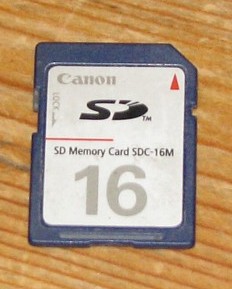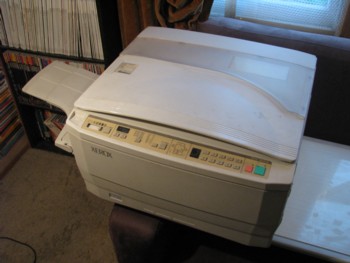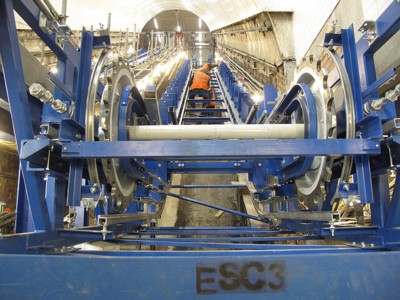We are developing the social individualist meta-context for the future. From the very serious to the extremely frivolous... lets see what is on the mind of the Samizdata people.
Samizdata, derived from Samizdat /n. - a system of clandestine publication of banned literature in the USSR [Russ.,= self-publishing house]
|
I recently had one of those eye opening web surfing sessions where I find lots of new awesome stuff to explore. I was checking up on the progress of Raspberry Pi, itself a very exciting project to make and sell an ARM-based PC board for $35. They say:
We want to see cheap, accessible, programmable computers everywhere; we actively encourage other companies to clone what we’re doing. We want to break the paradigm where without spending hundreds of pounds on a PC, families can’t use the internet. We want owning a truly personal computer to be normal for children. We think that 2012 is going to be a very exciting year.
I saw a video of a demo of Raspberry Pi running XMBC, which is open source media centre software designed to run on a PC connected to your TV and display all your photos and videos and play your music. During the demo, a movie is played and I happened to catch the title “Peach Open Movie Project”, which caught my attention.
It turns out that this is a short animated film made by the Blender Institute. Blender is open source computer animation and 3D design software. The Blender Institute in Amsterdam funds Blender related projects. For the past few years they have been making a short film each year. Peach was the codename for what became Big Buck Bunny. The film is completely open, Creative Commons licensed, and you can buy the DVD with all the assets, 3D models, scripts and tutorial videos showing you how to do all this stuff yourself. It strikes me that if you are a motivated teenager who wants to get into 3D animation your life is vastly better than it would have been 5 years ago in terms of the wealth of information available to you.
So far there are three Blender Institute movies and a computer game. My favourite is Sintel, a bittersweet fantasy about a girl and her dragon. Currently the Blender people are working on a fourth movie: project Mango. This is a “VFX-based” movie, which I take to mean real actors and filmography composited with 3D computer graphics. Blender can do camera and object tracking, so you get things like digital makeup and augmented reality. One of the main aims of these projects is to improve the Blender software, so at the end of each one, Blender is better; the free tools for making movies are better.
One of the guys working on project Mango is Ian Hubert who makes the sort of SF art that I love. He made a short film called Dynamo in his spare time, and is working on another independent, no budget movie called Project London that is made by compositing 3D digital elements onto live action. His showreel is particularly impressive.
If you look at the quality of these projects as compared to a big Hollywood movie like Avatar you will find that the gap is not so wide; certainly it is less wide than the same gap measured a few years ago. All this is being done using freely available tools that are getting better all the time. These tools and these projects may be offshoots of commercial projects or spare time projects, but now they exist the next iteration of artwork done with them will be better. We are all richer as a result and none of this is going away. It is one small aspect of economic growth that is very visible.
It is possible to get a sense of a what a lot more growth would bring: an economy where the essentials are cheap enough to leave us with even more time to work on projects like these; whether making movies or developing circuit boards or designs to be 3D printed.
Now consider this comment left on Eric Raymond’s post about SOPA. Shenpen is talking about the problem of software and movie piracy and how the business models are flawed. The problem, he says, is that music is not scarce.
So the long-term answer is much more simple: selling non-scarce things is going to be stop being a for-profit business in any form whatsoever.
Take music. There will be no profits. There will be no music industry. And most musicians will not be able to make a living out of it. It will stop being a viable business model and a way to make a living altogether. Sure, some musicians will make a living out of fundraisings, advertisements and live performances, but it no longer will be a reliable way to make a living.
Is it wrong – how? The profit motive is great for a lot of things and not so great for a lot of other things. Some things – like sex – are best given for free. Take away the commercial motive and what you get is a lot better music. Sure, musicians will often have to work a day job and thus have less energy to invest in making music. This will reduce quantity – so what? As for quality, I think that will counterweighted by that then they won’t invest their energy into making plastic crap but genuinely good stuff, stuff they themselves would want to listen to, stuf they want to remembered for. When money gets out of the picture, artists often discover they have better tastes than formerly thought.
Why do we have to limit our imagination to the way these things are being done now? Record sales, movie sales etc. did not exist 150 years ago, why should they exist in 50 years from now? Time for some innovation.
This kind of innovation is just what we are seeing. Anyone can make a feature film or record an album and put it on the Internet. As the tools improve, so does the quality of the work done. It would be nice to make a living out of movies and music, but if the cost of living is low enough, and with freely available tools, high quality movies and music will be made even if it is not possible.
3D printing with chocolate. More here.
Is this the killer app that 3D printing has been waiting for?
As I’ve recently been mentioning here, I have lately been doing lots of clearing out of junk from and organising of my home, which is a very satisfying activity. While doing this today, I had another of those haven’t-things-been-progressing-a-lot-lately? moments:
The point being that that’s 16 megabytes. Not gigabytes, megabytes. This thing came with one of my earlier digital cameras, from about eight or nine years ago, and in fairness 16mb was rather stingy even then. The card could only have accommodated four photos of the size of the photo I just took of it.
I seem to recall an earlier moment of this sort, also recorded here, and also involving an SD card. Yes. Despite all the financial woe we are now suffering, this kind of progress still seems to be hurtling along.
Just wait until I get stuck into all those back issues of Personal Computer World that I also find I still have.
Yes. This …
… has finally moved out of my home, and out of my life. Last week, Men collected it and took it … I don’t know where. A dump, presumably.
I recently wrote here about the continuing life of physical books and about the limitations of the idea of the paperless office or paperless home. Office-working commenters piled in to describe the persistence of paper in their offices, often in the teeth of earlier diktats from on high to the contrary.
But as far as my own libertarian activities are concerned, I really have pretty much completely abandoned communicating on paper, with my own writing, and most definitely with anyone else’s. Which means that this machine, with which I once processed all the paper that I once processed, really had to go, if only to help me to accommodate my ever increasing hoard of books. Only inertia had caused the photocopier to linger on, in my kitchen. That, and the affection I still feel for something which once made such a difference to my life.
A simple way of describing what this machine did for me, and for a small gang of mostly London-based libertarians, from the 1980s until the early 2000s, is that it enabled us to do something like blogging, before there was blogging. → Continue reading: My photocopier – 1981-2012
If you are depressed about the economic state of the world, one way to cheer yourself up is to google things like “fracking” or “natural gas”. Another is to try “3D printing”. That was how I found my way to this piece, about a company which has started selling 3D printers to … people. From what I can make out, each printer now costs something like two thousand dollars, more or less, depending on whether you want it ready to roll or are willing to assemble it yourself.
I can think of three things, right away, that are bound to be true about such “printers”. They will get cleverer. They will get cheaper. They will get smaller.
Currently, these gizmos seem to resemble those very early personal computers, circa 1975 (as I remember it). There are no very obvious things you can do with them, but despite that, they just reek of the future. Learn about them, and the next four decades of world technological history will be yours to surf at will, in ways that are impossible to know the details of but which are bound to be huge.
In due course, 3D printers may become no rarer than the 2D printers like the one I have on my desk are now. The first laser printer I blagged may way to using cost (someone else) around two thousand quid. My current one cost (me) about eighty quid, and is much better, not least because it is so much smaller. Presumably similar progress will occur with 3D printers.
I wonder what such machines will do to the world?
One of the things I notice about technological change is that it is, so to speak, quite abrupt but not completely abrupt. In historical terms, the arrival of, say, the printing press, was a huge upheaval, changing one reality to a completely different one. But on closer inspection, something like printing turns out to be a series of disruptions, including disruptions yet to come, rather than just one. And if you actually live through one of these disruptions, you typically experience it as something far more gradual and complicated than, say, a mere once-in-a-lifetime explosion.
Consider that old stager of our time, the “paperless office”, and in my personal case, its more chaotic younger sibling, the paperless home.
I have spent quite a lot of time during the last few weeks de-cluttering my home, and that has involved chucking out much paper. A particular clutch of paper that I am about to chuck out is a book. But it is not a book exactly. It is a pile of photocopied A4 pages. It is a big and cumbersome copy of a book, a copy of a copy. But it is a copy of an interesting book, one I would still like to own and consult. So, what am I replacing this biggish pile of paper with, which enables me still to read the same words? Answer: an actual book. Now that the internet enables me to buy an obscure book for coffee-and-a-sandwich money, but does not yet offer me an e-version of the same book, the logical thing to do is to buy yet more paper. In the long run, as Amazon knows better than anyone or anything else on earth, paper for reading will soon (in big historical time) be superfluous. In the meantime, Amazon circulates, hither and thither, still, a veritable mega-cyclone of … paper. For quite a few years, that was the only thing it did.
I am purchasing my new and smaller copy of this book from Oxfam, an enterprise I have no love for, and only have dealings with for private gain on my part, never purely because Oxfam itself benefits. The internet has opened up a whole new semi-business, in the form of people who can’t be doing with selling their own (often presumably inherited) piles of books on the internet, instead dumping these book onto charities, and charities then selling them for what they can get on the internet. (I sometimes suspect that the impact of Oxfam upon British society is far more profound and helpful than anything it does for places like Africa.) Again with the complication. Paper is not being chucked into a skip. It is, thanks to the internet, being rescued from the skip. Temporarily.
This is, as I say, the kind of process that does not show up in the big, broad brush history books, but it is typical of the complicated way that new technology works its complicated magic.
Another example of something similar that I recently learned of (and mentioned in passing in this earlier posting here, also about the complexity of technological change) is how the arrival of the railways caused a greatly increased demand for horses, to transport people to and from railway stations. In the long run, mechanised transport doomed the horse to becoming a mere leisure item. In the short run, it caused many more horses to be used.
Commenting on this reaction from Bishop Hill to a not-all-that-biased-by-their-standards BBC show about windfarms, regular BH commenter Philip Bratby says:
Only an idiot would consider building offshore wind farms (unless there is some other idiot prepared to give you huge sums of money to do it).
Bratby then mentions a website about a campaign called “Slay The Array”. Slay The Array seems to be an alliance between those who oppose these giant propellers on aesthetic grounds, and those who oppose them on economic grounds, and they have set their particular sites on a vast clutch of propellers (the “Atlantic Array”) which some gang of well-connected thieves and/or lunatics intend to build in the spot where the Severn Estuary turns into the Bristol Channel.
Personally I quite like the look of these giant propellers. But then, I like pylons, and skyscrapers, even scaffolding. As for wildlife, some of it will suffer if they build all these propellers, but other life forms will benefit, just as with every other human impact upon the environment.
However, I am entirely persuaded that, economically, these erections are ridiculous, in fact utterly fraudulent. So, for me, the biggest objection to them by far is this one:
The dash for wind energy is massively subsidised, making wind power three times more expensive than other power, paid for by increasing all our fuel bills, pushing millions into fuel poverty.
If Artists Against Windfarms (who get a mention at the Slay The Array website where it says “our friends”) oppose these stupid, larcenous but to me rather handsome propellers on artistic grounds, that’s fine by me.
I like this picture:
I found it here. It is an escalator in the process of being replaced, at Charing Cross underground station, London. They’ve taken out the old one. They are now remaking whatever it is the new escalator will sit on top off. Then they will put in the new esacalator. It’s a routine they must have done dozens of times, with local variations to keep them on their toes. I do not doubt that when they finish their work, the escalator in question will function smoothly, no matter how many people ride on it or how heavy their luggage.
What I like about the photo is that it is, for me anyway, a reminder that there are still some things about our world that are progressing very nicely. The engineering of things like escalators continues to improve. But because the complexity that you see in this picture is, when the final object is rolled out, hidden, most people only think of such things on those rare occasions when they don’t work. At which point they grumble.
One of the big divisions in the world now, it seems to me, is between those who assume that such progress will necessarily continue, no matter how many mistakes the politicians make, and those who do not. Some people take technological progress for granted, while others notice it (often because they do it themselves for a living), want it very much to continue, but do not assume that it automatically will continue, no matter what.
Here is an interesting article about growing fear-mongering about nanotechnology. Of course, even one of the founding fathers of the nanotech idea, Eric Drexler, has warned about the underside of this technology.
This might be the only measurement you need to judge the Afghanistan War. Vendors in Kabul are doing a brisk trade in Taliban ringtones. Because Afghans report that the Taliban kill travelers at clandestine checkpoints if they don’t hear one of their messages on someone’s phone.
– The opening sentences of a Wired piece by Spencer Ackerman entitled Either Your Phone Plays Taliban Ringtones, or You Die
Wise words from David Thompson. He supplies video to prove his point, video which reminds me of the scene in Road Trip, where the snake tries to eat Tom Green.
This posting has nothing to do with France.
A reminder of earlier dramas in London and surrounding parts this year:
A court on Wednesday sentenced a rioter who was caught on video pulling a man off his scooter during the summer riots to almost six years in jail.
The footage of Ryan Kitchenside, 18, chasing his victim before yanking him to the ground during the August riots in Croydon, appeared on video-sharing website Youtube, leading to his eventual identification.
Equally depressing is how other rioters joined in to help, as in to help Ryan Kitchenside.
It won’t end up as six years, but it will still be something. I recall reading elsewhere, somewhere, that the regular criminals are beating up rioters in prisons, because regular prisoners don’t like their own neighbourhoods being trashed either, and because regular prisoners are having to be moved around to accommodate the new arrivals.
Read the story and view the video here.
Here is the same video at YouTube, with added sound. That video looks like it was done by a human, rather than any CCTV machine. I am not YouTube savvy enough to find out who held the camera and what the story was there. Anyone?
|
Who Are We? The Samizdata people are a bunch of sinister and heavily armed globalist illuminati who seek to infect the entire world with the values of personal liberty and several property. Amongst our many crimes is a sense of humour and the intermittent use of British spelling.
We are also a varied group made up of social individualists, classical liberals, whigs, libertarians, extropians, futurists, ‘Porcupines’, Karl Popper fetishists, recovering neo-conservatives, crazed Ayn Rand worshipers, over-caffeinated Virginia Postrel devotees, witty Frédéric Bastiat wannabes, cypherpunks, minarchists, kritarchists and wild-eyed anarcho-capitalists from Britain, North America, Australia and Europe.
|






